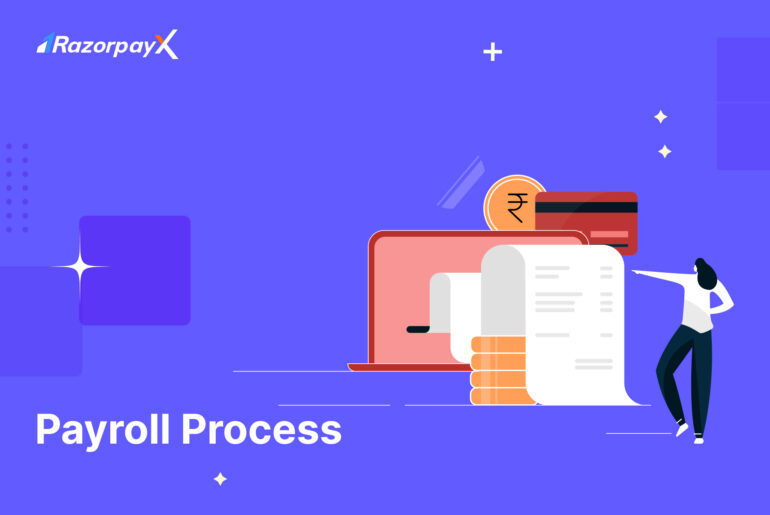Table of Contents
What is Payroll Processing?
Payroll processing is a complex set of steps that involves calculating and compensating employees for their work. It’s very important to carry out the payroll process timely and accurately to avoid penalties and fines.
This is why most businesses work with a payroll service provider or software instead of processing payroll manually. Today’s most popular option for businesses is payroll software like RazorpayX Payroll, which allows for automated compliance, calculation and payments.
How to Manually Process Payroll?
Manual payroll processing is only possible for a small business with a handful of employees; it is not feasible to process payroll manually for a medium or large-sized business.
The first step is to collect employee information. This includes timesheets or attendance tracking, basic salary, Dearness Allowance (DA) if applicable, and any Leave Encashment claims. This information is usually recorded on a spreadsheet.
This information can be used to calculate gross salary: add basic pay and DA, and deduct professional tax, EPF, ESI and any other income taxes applicable. The final amount is then sent to the employee.
As the number of employees grows, tracking each employee’s payroll information and calculating salaries becomes very tedious and error-prone. This is why most growing businesses choose a payroll software to handle their entire payroll process end-to-end.
Basic Steps in Payroll Processing
Establishing a payroll process should be one of the first systems put in place as a business scales. Unorganized systems and delays in paying salaries can severely impact the business’s reputation and affect its ability to attract top talent.
Here are the steps in the payroll process, along with tips on how to optimize every step of the way.
Obtaining a Permanent Account Number (PAN)
It’s important for employers to have a PAN for proper payroll processing. PAN is used for TDS deduction and when filing income related taxes. As a first step, ensure your business has a PAN for smooth and compliant payroll processing. You can apply for a PAN card for your business on the NSDL website.
Define Payroll Policy
A well-defined payroll policy ensures that everyone involved understands the calculations involved. This fosters transparency and reduces confusion and potential non-compliance.
Creating a payroll policy is an investment in accuracy, efficiency and employee morale. A good payroll policy addresses how often employees are paid and how the payment is made (direct deposit, paper checks). It also outlines deductions like taxes, EPF contributions and insurance.
Finally, payroll policy should establish guidelines for overtime pay, sick leave, leave encashment, potential payroll errors and full-and-final payments for departing employees.
Collecting Employee Information
The next step in the payroll process is to collect employee information. This includes details like employee name, address, PAN, investment declarations, etc.
Each department collects this information during onboarding, and the HR and finance team maintains these records digitally or manually. The HR and finance team also maintains records concerning employee time and attendance, leaves, loss of pay or salary revisions.
Recording and keeping track of these details for more than a handful of employees is impossible to do manually. Tools like RazorpayX Payroll have self-serve modules where employees can input their information independently. This information is stored securely and made accessible to the employer at the click of a button.
Calculating Employee Pay & Taxes
Once employee information has been collected, employers can begin calculating employee pay.
This includes calculating regular wages, overtime pay, and bonuses. Employers should use the most up-to-date wage and hour laws to ensure they are paying their employees the correct amount.
After calculating employee pay, employers must deduct taxes and other withholdings. This includes income tax, TDS and any other applicable deductions. Employers should be sure to comply with all applicable tax withholding laws and regulations.
Quick tip! These calculations are very important – if not done accurately, employees may receive a less or more than they are owed, which can lead to legal and reputational damage to the business. With an automated payroll system, all payroll is auto-calculated with the most updated tax laws and compliances in mind.
Distributing Paychecks
Once the employer arrives at the final net payable amount, it is time to disburse salaries. Most businesses choose to do this on a monthly basis, either on the 1st of the month or the last day of the month.
Employers can distribute paychecks to their employees electronically or by paper check. Electronic payments are becoming increasingly popular, as they are more convenient and efficient for both employers and employees.
Quick tip! With automated systems, you will never miss a scheduled salary payment again. RazorpayX Payroll allows employers to auto-pay and auto-deduct compliance like TDS or income tax.
Payroll Compliance
Employers must comply with all applicable payroll laws and regulations. This includes things like minimum wage, overtime pay, and tax withholding requirements. Employers who fail to comply with payroll laws and regulations may face fines and penalties.
RazorpayX Payroll is the ONLY tool offering automated compliance for small and enterprise-level businesses.
Get RazorpayX Payroll for Your Business
Challenges in the Payroll Process
Getting payroll right is very important. Getting paid is the single most important thing for employee morale. There are also dozens of government regulations around payroll taxes and regulations, which, if flouted, can be very costly for a business.
Ensuring compliance with tax regulations, payroll laws, and other statutory requirements can be complex and time-consuming – especially with the constantly changing landscape. It is important to calculate and deduct employee pay as accurately as possible since even small mistakes can lead to fines and penalties.
Failure to pay employees on time and accurately can seriously affect employee morale and motivation to work. Employees who are not paid on time or accurately may experience financial hardship, such as being unable to pay their bills or meet their basic needs. This can cause stress and anxiety for employees, which can make it difficult for them to focus on their work and perform at their best.
These employees are also more likely to look for a new job where they will be paid fairly and on time. This can lead to high employee turnover, which can be costly and disruptive for the employer.
Payroll Processing Tips for Employers
Keeping these challenges in mind, here are a few tips for employers to make the payroll process as smooth as possible.
- Be aware of the latest Indian payroll laws and regulations. The Indian government frequently updates its payroll laws and regulations, so it’s important to stay up-to-date to avoid compliance issues. You can find the latest payroll laws and regulations on the website of the Ministry of Labour and Employment.
- Choose the right payroll software. Payroll software can help you automate the payroll process and reduce the risk of errors. When choosing payroll software, ensure it complies with Indian payroll laws and regulations.
- Outsource payroll processing to a third-party provider. If you don’t have the time or resources to handle payroll processing in-house, you can outsource it to a third-party provider. Third-party payroll providers have the expertise and resources to ensure that your payroll is processed accurately and on time.
- Be aware of the different types of payroll taxes in India. The main types of payroll taxes in India are Provident Fund (PF), Employee State Insurance (ESI), and Professional Tax (PT). The amount of payroll tax that is deducted from an employee’s salary depends on their salary and other factors.
- Use a Permanent Account Number (PAN) to deposit salaries. All employees in India are required to have a PAN. Employers must use the PAN to deposit salaries into employees’ bank accounts.
- Submit Form 16 to the Income Tax Department of India. Form 16 is a tax certificate that employers must provide to their employees at the end of each financial year. The certificate shows the employee’s salary and the amount of tax that was deducted from their salary.
- Use a payroll management system that is compatible with Indian payroll laws and regulations. There are many payroll management systems available on the market, so it is important to choose one that is specifically designed for the Indian market.
- Keep all payroll records up-to-date. This will help you avoid any discrepancies in payroll records and to ensure that your employees are paid correctly.
- Train your employees on the payroll process. This will help them to understand how the payroll process works and to avoid any confusion.
- Be transparent with your employees about their payroll. This will help to build trust and confidence between you and your employees.
FAQs
What is the difference between gross pay and net pay?
Gross pay is the total amount of money earned by an employee before any taxes or withholdings are deducted. Net pay is the amount of money left after all taxes and withholdings have been deducted.
What are the different types of payroll taxes?
There are different types of taxes like income tax, professional tax, as well as deductions like PF.
How often should I pay my employees?
Employers are required to pay their employees at least once per pay period. The pay period can be weekly, biweekly, semi-monthly, or monthly.
What are the benefits of outsourcing payroll?
Outsourcing payroll can save employers time and money. Payroll providers can handle all aspects of the payroll process, from calculating employee pay to deducting taxes and withholdings. This can free up employers to focus on other aspects of their business.
How long does payroll take to process?
Manual payroll processes can take weeks to process. However, with digital payroll solutions like RazorpayX Payroll, processing payroll is only a matter of minutes.
What is full cycle payroll processing?
The time between each salary payment is a payroll cycle. Depending on the payroll policy of the business, it can be as short as a day or even several months together. The full cycle of payroll starts with tracking employee information and ends with making the payment.
What are the types of payroll processing?
Payroll processing can be classified in two main ways: by method of execution and implementation. Payroll can be executed in two ways: in-house payroll or outsourced payroll; payroll can be implemented in two ways: manually or with automation.





